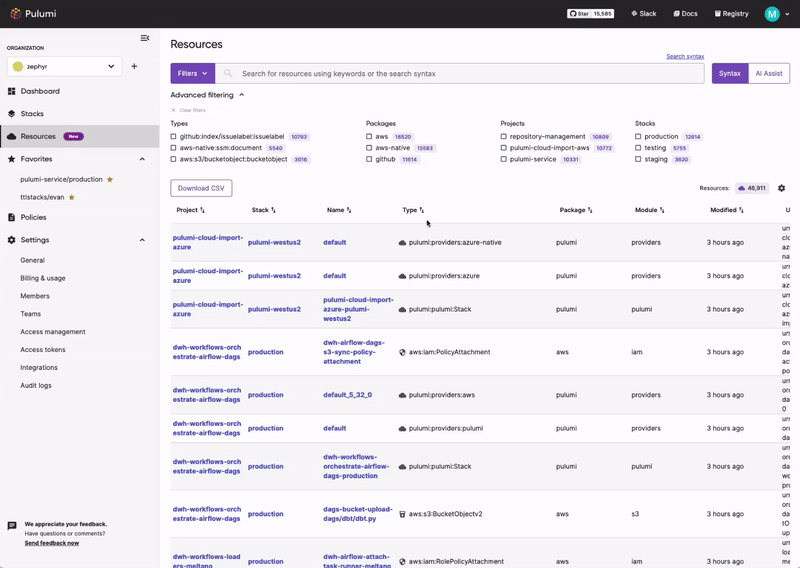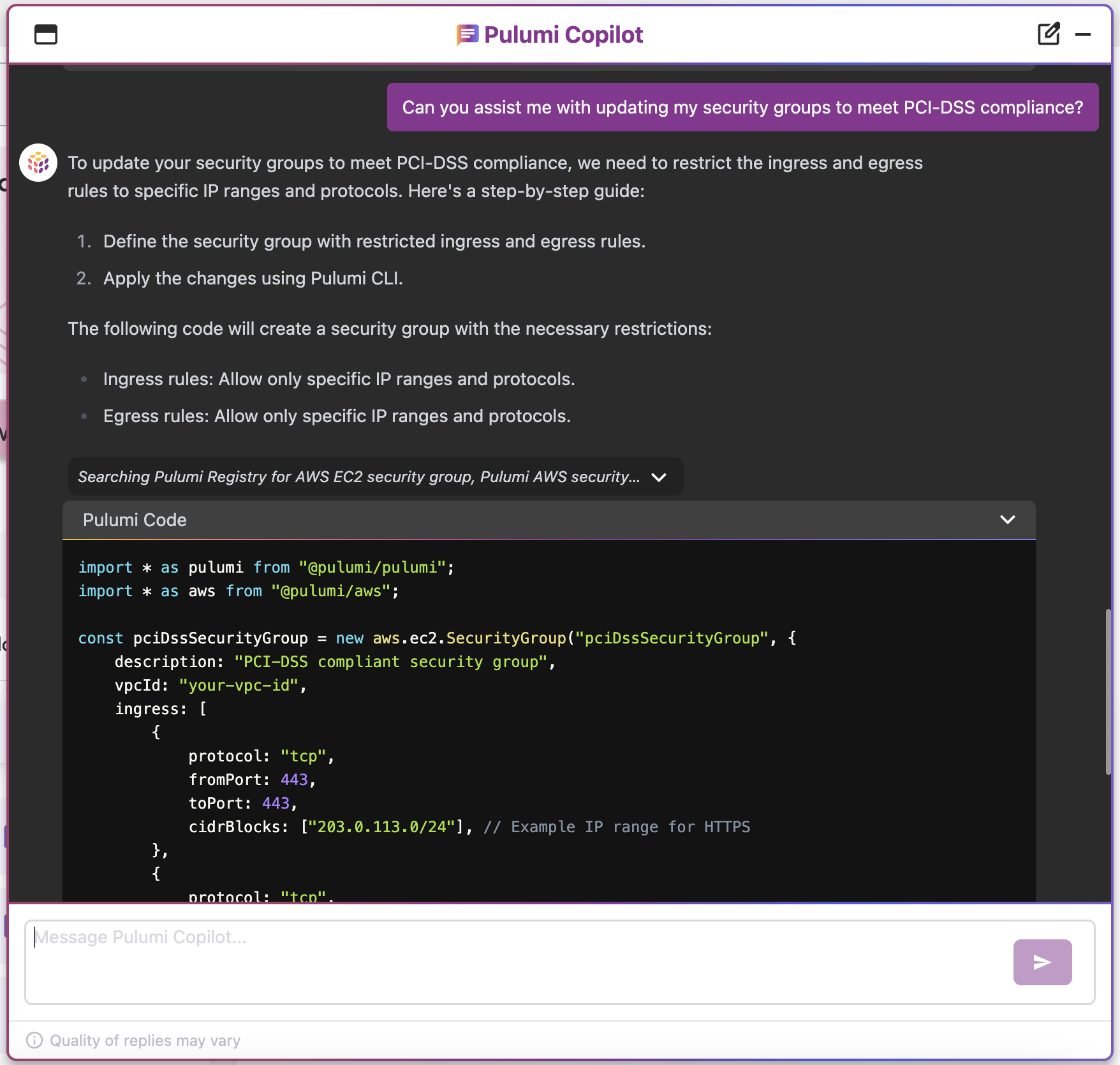CIS Compliance for Google Cloud
CIS Compliance for Google Cloud
CIS compliance is crucial for establishing strong security controls and safeguarding your cloud infrastructure against cyber threats. Pulumi can help you identify existing cloud resources that are not in compliance, and it can also enforce compliance policies proactively before infrastructure is deployed. Get started with Pulumi to use these compliance tools or speak with a Solutions Architect to get an expert consultation.
What is CIS Compliance?
CIS (Center for Internet Security) Compliance refers to the adherence to security best practices outlined by the CIS, a nonprofit organization that develops globally recognized security standards. These best practices are known as CIS Controls and CIS Benchmarks, which provide guidelines for securing various technologies and systems, including operating systems, cloud services, network devices, and software.
Key Aspects of CIS Compliance
- Implementation of Controls: Start by implementing the CIS Controls relevant to your organization's size and risk profile.
- Use CIS Benchmarks: Configure your systems and applications according to CIS Benchmarks.
- Regular Audits: Continuously monitor and audit your systems to ensure ongoing compliance with CIS recommendations.
- Automation Tools: Consider using CIS-CAT (CIS Configuration Assessment Tool) or other automation tools to assess and enforce compliance across your infrastructure.
Benefits of CIS Compliance
- Standardized Security: Ensures that your organization follows industry-recognized security best practices.
- Risk Reduction: Helps in reducing the attack surface by implementing critical security controls.
- Compliance with Other Standards: CIS Controls and Benchmarks often overlap with other compliance frameworks like PCI-DSS, NIST, and ISO, making it easier to achieve multiple compliance goals simultaneously.
- Improved Incident Response: By implementing CIS Controls, organizations are better equipped to detect, respond to, and recover from security incidents.
CIS Compliance for your Google Cloud Infrastructure
1. Identity and Access Management
- Root Account Protection: Ensure that the Google Cloud project's root account (Organization Administrator) is not used for everyday tasks and that Multi-Factor Authentication (MFA) is enabled for this account.
- Role-Based Access Control (RBAC) Policies: Apply the principle of least privilege by ensuring that IAM roles grant the minimum permissions required for users, groups, and services.
- MFA for Google Cloud Users: Require MFA for all Google Cloud users with console access.
- Password Policies: Implement strong password policies in Google Cloud, including complexity requirements, password expiration, and self-service password reset options.
2. Logging and Monitoring
- Google Cloud Audit Logs: Enable Google Cloud Audit Logs across all regions to record all management-level operations on your resources. Ensure logs are archived in Cloud Storage with encryption and immutability for added security.
- Cloud Monitoring: Set up Cloud Monitoring to track key metrics and create alerts for unusual activities, resource utilization, or threshold breaches.
- VPC Flow Logs: Enable VPC Flow Logs to capture information about IP traffic to and from resources within your Virtual Private Cloud (VPC).
3. Networking
- Firewall Rules: Ensure that your Firewall Rules are configured to allow only necessary traffic. Regularly review and restrict inbound and outbound rules.
- Public Access to Resources: Avoid public access to sensitive resources. Ensure that no firewall rules or Public IP addresses allow unrestricted access (e.g., 0.0.0.0/0) unless explicitly required and properly monitored.
- Bastion Hosts: Use Bastion Hosts for secure SSH or RDP access to resources. These should be the only publicly accessible VMs and tightly controlled.
4. Encryption
- Cloud Storage Encryption: Ensure that all Cloud Storage buckets use server-side encryption (SSE) to protect data at rest. Enable default encryption for all new storage buckets.
- Cloud SQL and Persistent Disk Encryption: Enable encryption for Cloud SQL and Persistent Disks, including data at rest, backups, and transparent data encryption (TDE).
- Cloud Key Management Service (KMS): Use Cloud Key Management Service (KMS) to manage and rotate encryption keys. Ensure that access to KMS keys is restricted through IAM and monitored with audit logs.
5. Auditing and Assessment Tools
- Organization Policy: Use Organization Policy to assess, audit, and enforce the configuration of your Google Cloud resources. Set up compliance policies that align with CIS Benchmarks and trigger alerts for non-compliance.
- Security Command Center: Enable Security Command Center to aggregate security findings, compare them against best practices, and offer recommendations. Security Command Center also helps monitor compliance and generate reports.
- CIS-CAT Tool: Use the CIS Configuration Assessment Tool (CIS-CAT) to automate the assessment of your Google Cloud environment against the CIS Benchmarks.
6. Automation and Continuous Compliance
- Infrastructure as Code (IaC): Use tools like Pulumi to define your infrastructure as code. This ensures that CIS-compliant configurations are applied consistently and efficiently across environments.
- Automated Remediation: Implement automated remediation for non-compliant resources using Cloud Functions or Organization Policy to enforce continuous compliance.
- Continuous Monitoring: Regularly monitor your environment with tools like Cloud Monitoring, Organization Policy, and Security Command Center to ensure ongoing compliance with CIS benchmarks.
7. Documentation and Reporting
- Compliance Documentation: Maintain up-to-date documentation of your CIS compliance efforts, including policies, configurations, and monitoring setups in your Google Cloud Source Repositories or documentation repositories.
- Regular Audits: Schedule regular internal audits using Google Cloud Compliance Manager to review configurations against the CIS benchmarks and update them as necessary.
Pulumi Insights
Use Pulumi Insights to gain visibility into your cloud infrastructure's configuration to assess CIS compliance. Pulumi Insights is Intelligent Cloud Management. It helps you gain security, compliance, and cost insights into the entirety of your organization's cloud assets and automatically remediate issues.

Pulumi Copilot
Use Pulumi Copilot to assist configuring your infrastructure to make it compliance ready. You can tap into the Pulumi Copilot's deep understanding of your organization's context to gain visibility into the configuration of resources and assess their compliance.

Compliance Ready Policies
With comprehensive coverage of Google Cloud, Pulumi Compliance Ready Policies provide an enhanced level of control and governance over your cloud resources. Pulumi Compliance Ready Policies empower you to enforce best practices, security standards, cost controls, and compliance requirements seamlessly within your infrastructure-as-code workflows.
Compliance for Google Cloud Services
Learn more about how Pulumi can make your Google Cloud services CIS compliant.
Talk to a Solutions Architect
Get in touch with our Solutions Architects to get all your resources in use with Pulumi Insights